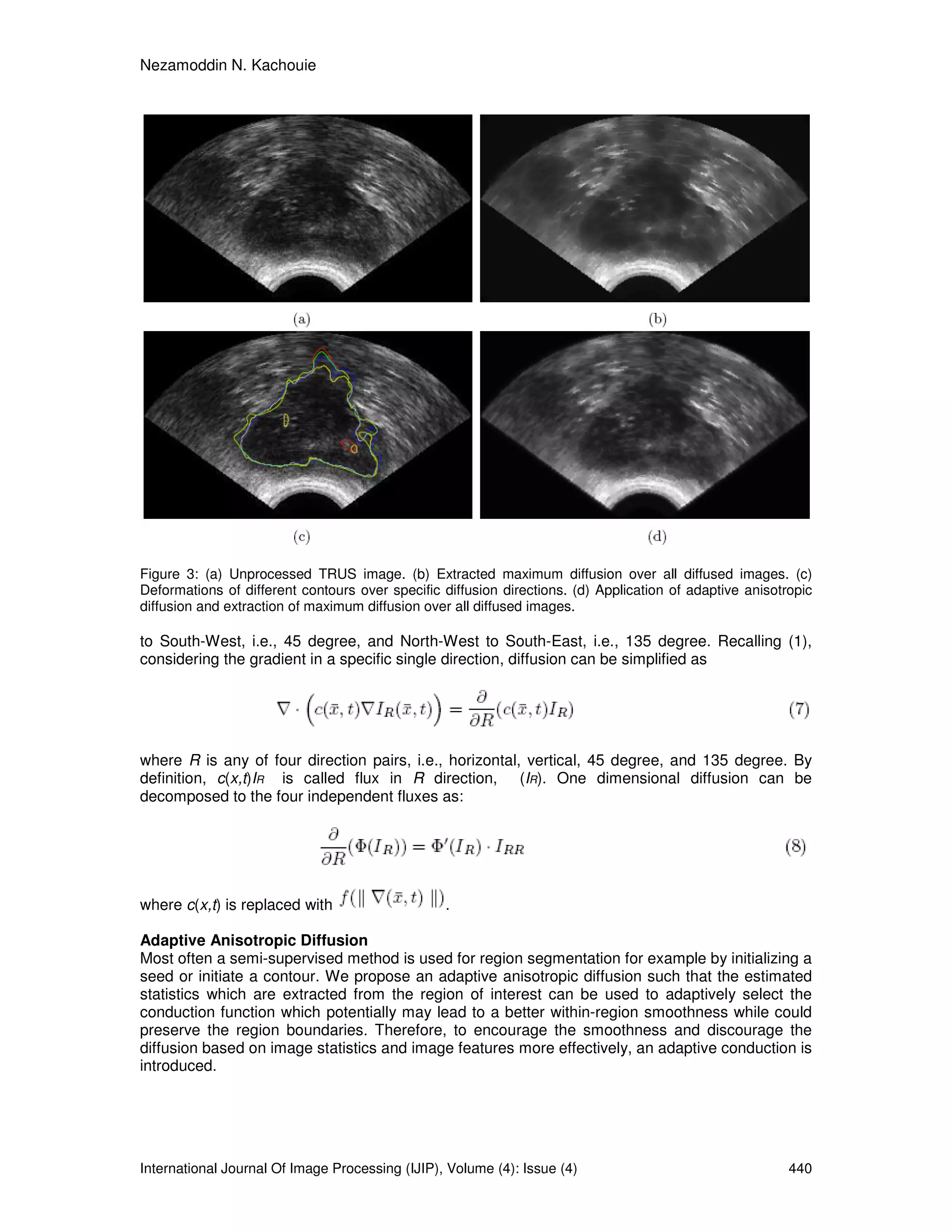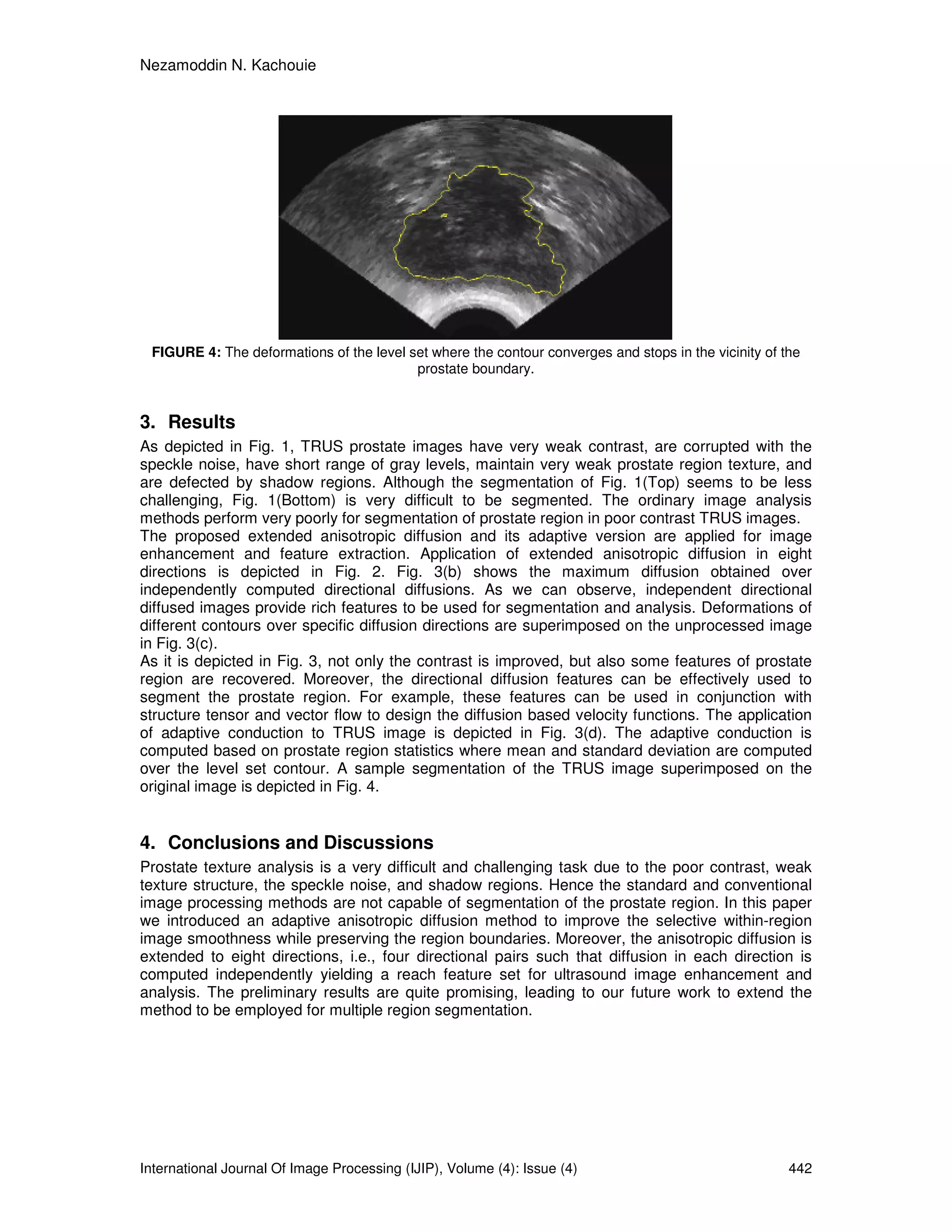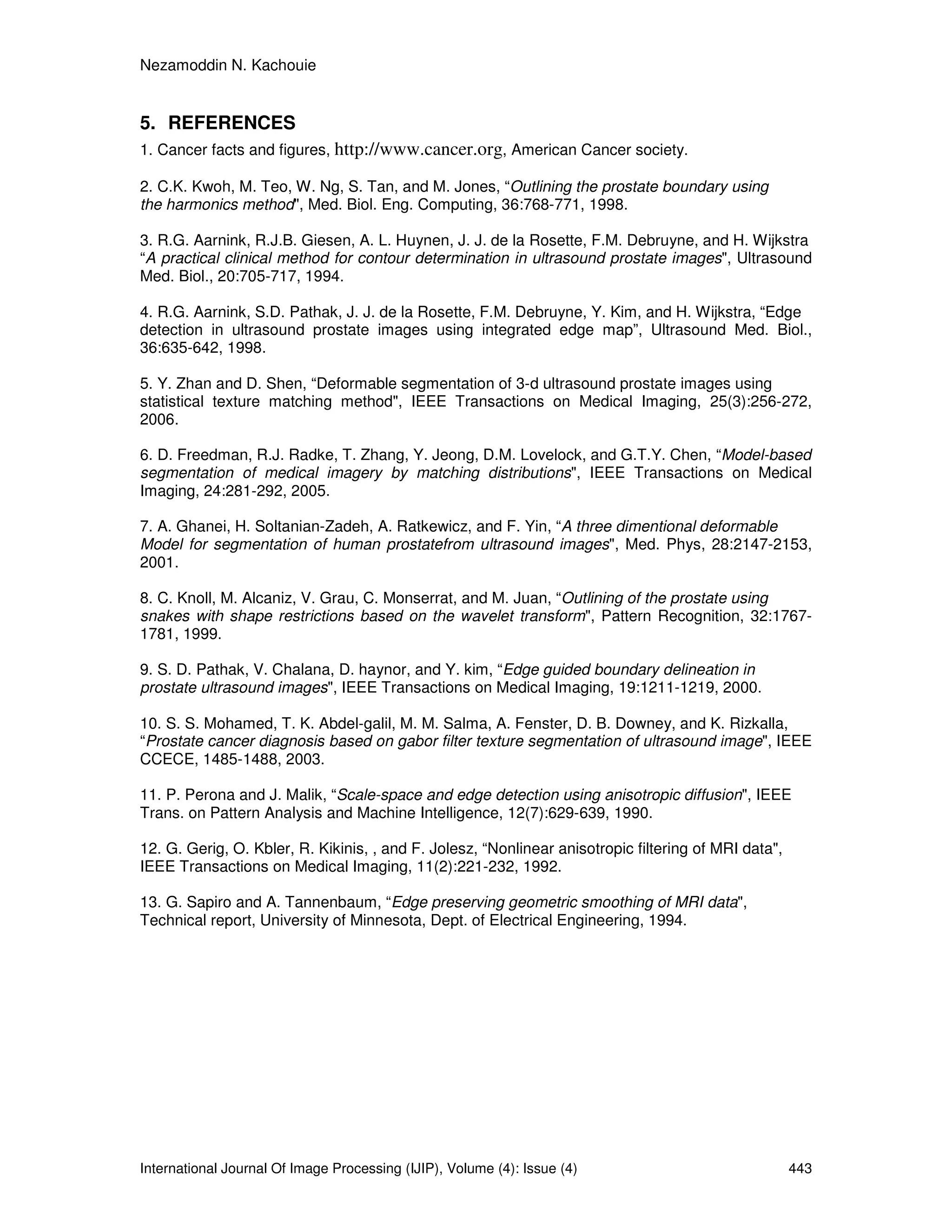The paper discusses using extended anisotropic diffusion for enhancing the contrast of trans-rectal ultrasound (TRUS) images to improve prostate segmentation, which is vital for prostate cancer diagnosis. It introduces an adaptive anisotropic diffusion method that computes diffusion values in multiple directions and utilizes region statistics for optimized segmentation. Preliminary results indicate promising enhancements in feature extraction and image analysis for better prostate region delineation.
![Nezamoddin N. Kachouie
International Journal Of Image Processing (IJIP), Volume (4): Issue (4) 436
Anisotropic Diffusion for Medical Image Enhancement
Nezamoddin N. Kachouie nezam.nk@gmail.com
Department of Systems Design Engineering,
University of Waterloo, Waterloo, ON, Canada
Present Affiliation: Harvard-MIT Health
Sciences and Technology Harvard
Medical School, Cambridge, MA, USA
Abstract
Advances in digital imaging techniques have made possible the acquisition of
large volumes of Trans-rectal Ultrasound (TRUS) prostate images so that there is
considerable demand for automated segmentation of these images. Prostate
cancer diagnosis and treatment rely on segmentation of TRUS prostate images.
This is a challenging and difficult task due to weak prostate boundaries, speckle
noise, and narrow range of gray levels which leads most image segmentation
methods to perform poorly. Although the enhancement of ultrasound images is
difficult, prostate segmentation can be potentially improved by enhancement of
the contrast of TRUS images. Anisotropic diffusion has been used for image
analysis based on selective smoothness or enhancement of local features such
as region boundaries. In its conventional form, anisotropic diffusion tends to
encourage within-region smoothness and avoid diffusion across different regions.
In this paper we extend the anisotropic diffusion to multiple directions such that
segmentation methods can effectively be applied based on rich extracted
features. A preliminary segmentation method based on extended diffusion is
proposed. Finally an adaptive anisotropic diffusion is introduced based on image
statistics.
Keywords: TRUS Imaging, Deformable Models, Level Sets, Anisotropic Diffusion, Segmentation.
1. INTRODUCTION
As the most diagnosed cancer, prostate cancer is the second leading cause of the cancer death
in North America [1]. Hence diagnosis of this cancer in its early stages is crucial. Prostate TRUS
images, in comparison with the other modalities such as CT and MRI, are captured more easily,
in real-time, and with lower cost, so they are widely used for the diagnosis of prostate cancer,
cancer treatment planning, needle biopsy, and brachytherapy. The size and the shape of the
prostate must be determined by prostate segmentation to diagnose the cancer stage. Although in
the traditional approach, an expert infers this information manually from the TRUS images, such a
manual method is tedious, expensive, time consuming, and subjective. Given the increasing
amount of TRUS data being collected, automated methods of TRUS prostate segmentation are in
high demand and different segmentation methods have been proposed [2, 3, 4, 5, 6, 7, 8, 9].
These methods include boundary segmentation, deformable models, and region segmentation
approaches.](https://image.slidesharecdn.com/ijip153-160215120049/75/Anisotropic-Diffusion-for-Medical-Image-Enhancement-1-2048.jpg)
![Nezamoddin N. Kachouie
International Journal Of Image Processing (IJIP), Volume (4): Issue (4) 437
FIGURE 1: Two TRUS prostate images.
The prostate region in TRUS prostate images usually maintains a very weak contrast against the
background. Because of the speckle noise, short range of gray levels, very weak prostate region
texture, and shadow regions the conventional image processing and analysis techniques are not
capable to effectively capture, discriminate, and segment the prostate region based on its
intensity, texture, and gradient. There have been some attempts by employing the Gabor filter
bank for prostate texture segmentation [10, 5], however prostate has a very weak texture and has
not yet been investigated seriously.
Anisotropic diffusion [11] was introduced by Prona and Malik to perform edge preserving and
within-region smoothing based on the differential structure of the image [12, 13]. Anisotropic
diffusion considers no prior information about the regions and boundaries, and does selective
diffusion based on local computation of a conduction term. Moreover, anisotropic diffusion
computes group diffusion as a single diffusion value for each spatial location by summation of
diffusions in four directions in each time step. There are some weak radial and angular features in
ultrasound images which potentially can be used to reveal weak structures and textures. Our goal
in this paper is extending anisotropic diffusion to multiple directions which are computed
independently for contrast enhancement of TRUS images. Therefore, eight anisotropic diffusion
values will be computed independently for each spatial location. This can provide a rich feature
space with potential use in image analysis and segmentation.](https://image.slidesharecdn.com/ijip153-160215120049/75/Anisotropic-Diffusion-for-Medical-Image-Enhancement-2-2048.jpg)
![Nezamoddin N. Kachouie
International Journal Of Image Processing (IJIP), Volume (4): Issue (4) 438
FIGURE 2: Application of extended anisotropic diffusion in eight directions. (a) North-South.
(b) East-West. (c) NE-SW. (d) NW-SE.
Moreover, considering a semi-supervised segmentation such as deformable models to initialize a
seed, we introduce an adaptive anisotropic diffusion in which the estimated statistics extracted
from the region of interest can be used to adaptively switch between different conduction
functions leading to better within-region smoothness while preserving the region boundaries.
2. The Proposed Method
Strong region boundaries are desired for image segmentation, however image denoising tends to
smooth sharp boundaries of the image and reduces the image contrast. To overcome this
drawback of image denoising methods, anisotropic diffusion method, as an alternative to linear-
filtering was introduced by Perona and Malik [11]. Anisotropic diffusion considers a conduction
term that is locally computed and depends on the differential structure of the image. Anisotropic
diffusion filter was used by Gerig et al. [12] to enhance MR images. To perform edge preserving
and within region smoothing of MR images, Sapiro and Tannenbaum [13] used a similar
approach.
Anisotropic Diffusion
Perona and Malik [11] presented the anisotropic diffusion filter as a diffusion process that
encourages intra-region smoothness while inhibits inter-region smoothness. Mathematically, the
process is defined as follows:](https://image.slidesharecdn.com/ijip153-160215120049/75/Anisotropic-Diffusion-for-Medical-Image-Enhancement-3-2048.jpg)
![Nezamoddin N. Kachouie
International Journal Of Image Processing (IJIP), Volume (4): Issue (4) 439
where I(x,0) is the initial unprocessed image, x is the image coordinate and t is the iteration step.
c(x,t) is the diffusion function and is a monotonically decreasing function of the image gradient
magnitude. To encourage smoothing within a region and discourage it across different regions,
the conduction coefficient c must be set to one inside the region (smooth conduction) and set to
zero otherwise. For edge estimation to locate the region boundaries, the gradient of intensity
image is first obtained:
The conduction coefficient of diffusion is then computed locally as a gradient magnitude of local
image intensities:
By the proper selection of function f, not only region boundaries can be preserved but also edges
maybe sharpened. Any monotonically decreasing continuous function of could be selected as
a diffusion function. Two functions for local computation of the conduction to satisfy selective
edge smoothness and enhancement were suggested by Perona and Malik [11]. The first one
encourages high contrast edges over low contrast ones while the second function
encourages wide regions over smaller regions where k is the diffusion coefficient. The differential
relation in (1) can be discretized and be numerically implemented as
where Nc, Sc, Wc, and Ec are conduction in north, south, west, and east directions respectively
and is the step size.
Extended Diffusion
We extended anisotropic diffusion to multiple directions to be used to reveal weak radial and
angular features in ultrasound images. This rich feature set can be used for contrast
enhancement, image analysis, and segmentation. We apply anisotropic diffusion in eight
directions, generating four diffused images computed independently regarding four directional
pairs for each spatial location. Thus the anisotropic diffusion is computed for North-South and
East-West directions separately and is extended by introducing two new directions as North-East](https://image.slidesharecdn.com/ijip153-160215120049/75/Anisotropic-Diffusion-for-Medical-Image-Enhancement-4-2048.jpg)



